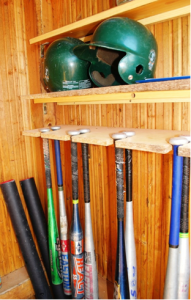When he was 17 years old, John A. “Bud” Hillerich invited Louisville Eclipse star Pete Browning over to a woodworking shop owned by his father, to build a new bat for replacing one Browning broke in a match. The next day, Pete managed three hits off it, and the Louisville Slugger was born, over 200 years ago.
That’s how important a good bat is: it doesn’t just last longer, it is critical to your batting performance. Bats have evolved over time and there’s a huge variety available, both for baseball and softball. You can practice your swing all you want, but without the right bat, you’re probably not going to be batting a 1000 anytime soon!
Features You Should Consider While Buying a Bat
- Size – Factors that affect a bat’s size include:
Length – There are a few different ways to compare bat lengths, but it all comes down to how comfortable they feel. The rule of thumb is to progress one inch at a time, so you can get comfortable without changing your swing. If you’re buying one for the first time, estimate the size you should start with according to your weight and height, or by measuring the distance from the center of your chest to the tip of your index finger.
Weight – Bat weights are calculated according to their length, called ‘drop weight’, so a 30-inch bat with a drop weight of (-5) will weigh 25 ounces. The balance between bat length and weight changes the physics of the swing. If you’ve picked the perfect length, try and go with one that’s just a bit heavier.
Barrel Size – A longer barrel provides a larger ‘sweet spot’ where a hit has the most effect. Some players prefer a smaller barrel diameter, which trades weight for added speed, without changing the length. A larger taper and cushioning can reduce the shock from impact; while a smaller one is lighter and lets you swing and rotate your wrists faster.
- Material – There’s a wide range of materials used to make bats, each with its own unique properties:
Wood – Heavier and less hitting power. Maple and ash are popular for their strength, hardness and density
Aluminium – Lighter, more durable, faster and higher hitting power. Aluminium bats tend to have a larger sweet spot
Graphite and Titanium – Added to thinner-walled aluminium bats to reduce weight, vibrations and impact shock
Alloy – Aluminium alloy with other elements to increase performance. Alloy bats with scandium tend to be the strongest
Composite – Top-of-the-line bats are usually composites. They are durable, and hitting power usually increases as they’re used. However, most cannot be used in cold weather (below 55?)
Hybrid – Usually an aluminum barrel and a composite handle, but they can be of many types, like composite shell with aluminum handle, or composite end caps
- Regulations – Before you decide on a bat, consider the regulations for matches you intend on participating in. Governing bodies for baseball and softball have different restrictions and approvals, and bats have the logos for certification printed on them.
The Bottom Line on Buying a Bat
Hitting speed and power increase with weight and length, respectively, but a large and heavy bat is also difficult to balance with. One of the simplest ways to check if you can manage a bat is to hold it outstretched at shoulder height for 10 seconds. If you can’t, it’s probably too heavy.
About the Author: J Mike loves straddling his two jobs. He works as an Online Marketing Manager for Red Raider Outfitter during day and loves to blog about fashion & sports when he is home. He loves to turn his thoughts on fashion & sports into words. Being a Texan who breathe sports, Mike loves to cheer for his team Texas Tech Red Raider during game days.












2 Responses